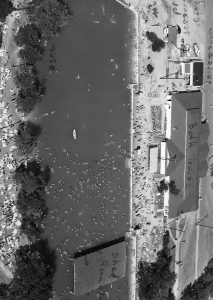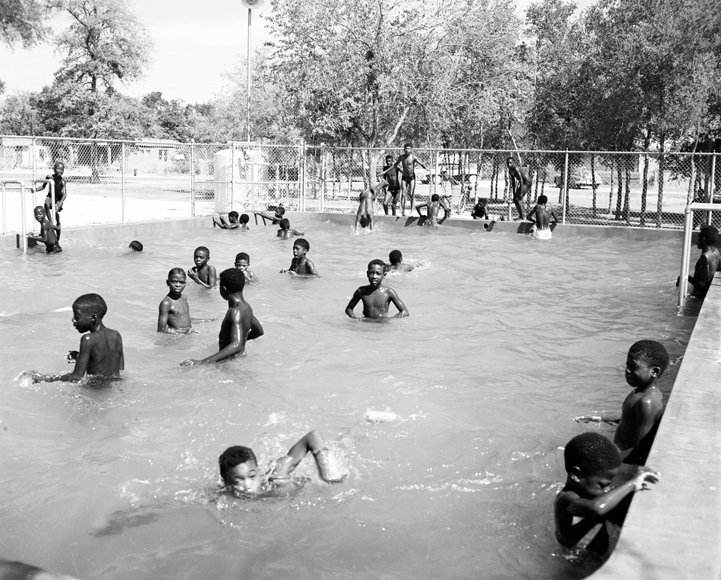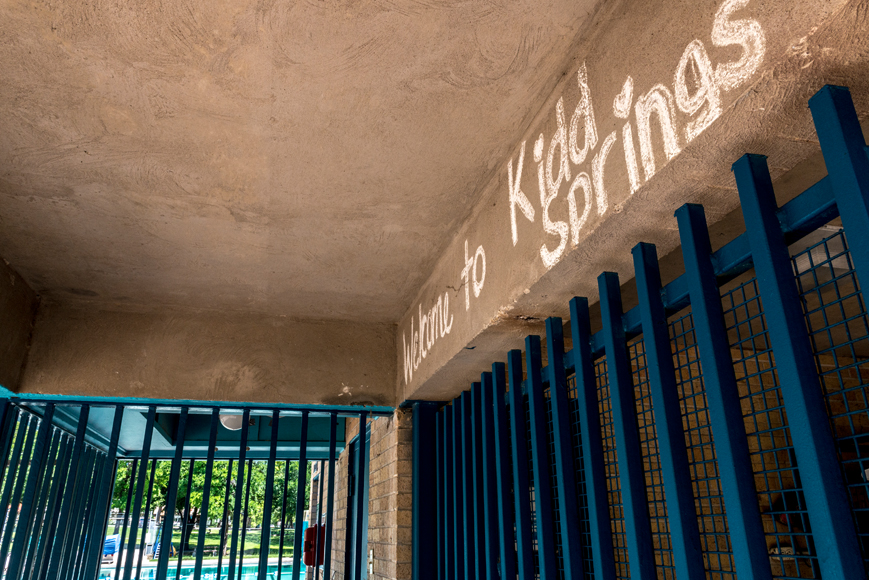It’s summer in Dallas and just one thing is known to lure folks from their comfy air-conditioned lairs
The thermostat seems stuck at 103 and, no, it is not broken. It’s just summer in Texas, where an indiscriminate barefoot on concrete or fingers on a metal seatbelt buckle can singe the skin. Our world is a sauna; everything’s sticky. The urge to cannonball into the nearest pool, splash around and soak up its chilly reprieve is fierce.

Lake Cliff was the place to swim in the ’40s and ’50s. (Photo courtesy of the Dallas Municipal Archives)
The amusement park at Lake Cliff, with its theater, skating rink, log ride, bowling alley and restaurant, drew big crowds in the early 20th century. It ultimately was a financial flop however, and the city bought it for $55,000 in 1914. The pool at Lake Cliff was built in 1921 and by 1945, it had generated a total of $100,000 in net revenue for the city. The city estimated that around 80 percent of the population had swum in the pool that year. It was a 310-square-foot all-concrete pool, 10 feet deep at the diving end with a 2.5 million-gallon capacity. It also had a sandy beach and bathhouses with showers and lockers. The city renovated the pool in 1949, expanding its sandy beach and adding underwater lights for night swimming. Several children drowned in the massive pool over the decades. That, along with ever-increasing maintenance costs, inspired the city to close it in 1959.
When James Kidd, a former colonel in the Confederate States Army, settled in what is now Oak Cliff in 1878, the spring on his property was a “gushing fountain” in the side of the hill. The spring “raced away down the valley, making a creek,” according to a 1924 oral history from his son, Wilber M. Kidd. E.P. Turner, for whom Turner House is named, bought the spring in 1895 and dammed it to make a lake for the Kidd Spring Boating and Fishing Club. In 1911, Kidd Springs was opened to the public. A 1927 newspaper story described Kidd Springs as 25 acres with “hundreds of beautiful shade trees” and a two-acre lake. A main attraction in the ’20s was the giant “devil’s slide,” into the water. It also had a sandy beach and an orchestra pavilion. The park operated as a private amusement park until 1947, when it became part of the City of Dallas park department. The same year, the city closed the Kidd Springs Park lake to swimming. In 1951, the newspaper reported that the once-gushing spring had been “reduced to a trickle” and today, the exact source of the spring is unknown. In 1959, the city opted to close the pool at Lake Cliff Park and build a new one at Kidd Springs. The previous summer, the city’s pool system had served about 900,000 swimmers. Admission to city pools cost 40 cents for adults, 25 cents for kids ages 12-17, and 15 cents for younger children. The pool at Kidd Springs Park cost about $74,000 to build and debuted on May 15, 1959. This summer is expected to be the last for the Kidd Springs Park pool. Construction on the new pool and bathhouse could begin next May; the new pool is expected to open for the 2018 season.

Children swim in the Exline Park pool during segregation. (Photo courtesy of the Dallas History &
Archives Division, Dallas Public Library)
1945 saw the modern era of public swimming pools emerge and progress during a time of desegregation and accompanying unrest. Swimming pools became a flashpoint for racial contention, notes professor Jeff Wiltse in his book, “Contested Waters: A Social History of Swimming Pools in America.” “Racist assumptions that black Americans were more likely to be infected with communicable illness,” inflamed opposition to racial integration, Wiltse wrote. Also, gender mixing at pools was relatively new, and white swimmers objected “to black men interacting with white women at such visually and physically intimate spaces,” he adds. “In my book, I have pictures of black Americans who lie still on the ground with bloody heads from being pummeled, just for trying to access a swimming pool,” Wiltse said in an NPR radio interview. Park director L.B. Houston and members of the Dallas park board in the mid-20th Century understood the perils of integrating pools. “We could see the time when racially mixed swimming would be with us,” Houston says in a 1973 oral history, provided by the Dallas Municipal Archives. “We had the feeling that the very last thing that white people would tolerate would be mixed swimming. We thought it would be dangerous, you know, perhaps mob violence.” In Dallas, no written rule of racial segregation at park property existed. Rather, segregation was socially enforced, according to the Dallas Park and Recreation Department’s centennial history. “Black citizens risked harassment or worse for using white facilities.” In addition to Kidd Springs, a couple of large municipal pools served Dallas swimmers in the early 1900s. South Dallas’ Exline Park, named for Marcus Page Exline, a Dallasite who founded the M.P. Exline Printing Co., offered a park and junior pool for black residents beginning in the 1920s. A community pool was built there in the 50s. Imbalance in amenities grew increasingly evident over the years. A 1944 Dallas Morning News article reported that the city offered 60 acres of park for its 60,000 black residents. In contrast, 5,000 acres were reserved for its 320,000 white citizens. Compared to other southern cities, Dallas managed to make a relatively peaceful transition to integrated pools, according to city archivist John Slate, who co-wrote a paper with current Dallas park director Willis Winters about the desegregation of Dallas parks. In their essay, “A means to a peaceful transition,” Slate and Winters credit former Dallas park director L.B. Houston with leading “a quiet revolution that was a bright spot in an otherwise tumultuous time in the city’s relationship with its black citizens.” Park board members Ray Hubbard and Julius Schepps worked closely with Houston, according to Slate, “within the confines of institutionalized segregation to encourage the peaceful transition to an integrated park system.” Houston explained in his oral history how he and the board devised a new public-swimming program while gradually integrating. They developed a grid system of communities, both black and white, with a swimming pool at the middle of each. These smaller pools would progressively replace the existing large municipal swimming facilities. The idea was directly tied to equal rights and desegregation. “Houston surmised that providing more pools in more neighborhoods would distribute them more equitably throughout Dallas while reducing the chances of confrontation,” note Slate and Winters. Houston began keeping close track of the racial makeup of Dallas neighborhoods relying on employees who lived in transforming neighborhoods for information. He plotted data about racial trends and attitudes on a map hung in his office, which he used to make desegregation decisions. “I never will forget the day [Schepps] called me and said, ‘L.B. are we ready to mix?’ By that time I think we had six or maybe nine pools. I told him my opinion that some could and others, doubtful,” Houston said in his oral history. When it became clear a neighborhood was nearing a black-majority population, the local park was closed for a month and reopened as a “black” park. “By that time, most whites had moved on, and the park had been peacefully transitioned,” according to Houston’s oral history. “This method was used successfully for both Lagow and Exline parks, which served neighborhoods that had seen some of the most violent responses to integrated housing in Dallas’ history,” according to Slate and Winters. Exline, for example, was the site of racially motivated bombings in the 1950s. That strategy was employed around the city, arguably resulting ultimately in equal amenities for black citizens. Years later Houston would have to defend the park department’s seeming silence on issues of integration. A trade magazine called “Amusement Business” noted in 1961 that Dallas desegregated parks, golf courses and other recreational facilities but explicitly left public pools out of their agreement with civil rights leaders. Houston defended his board’s methods, which, he pointed out, was supported by the Negro Chamber of Commerce and other local black groups. “You were doing everything you could to prevent open rebellion. Because we were living on a powder keg. And when and if a revolt had ever been precipitated well, gosh, no telling where you would have ended up.” Was it right to perpetuate socially segregated facilities? “No,” write Slate and Winters in their paper. “However, as agents of change from the inside they realized that whatever they could do from their positions would benefit a larger movement, and that anything that could prevent violent confrontation was better than the alternative.”






